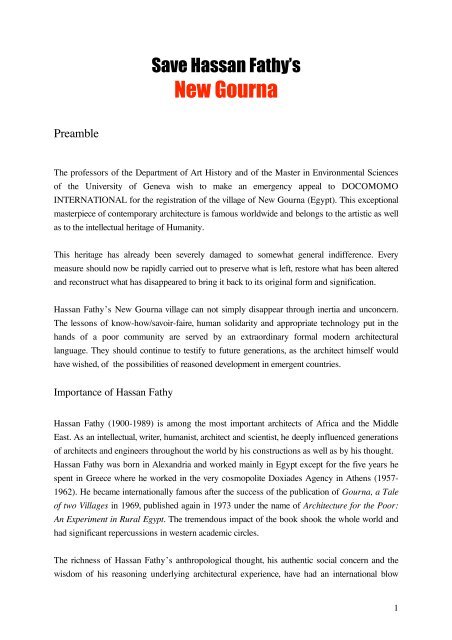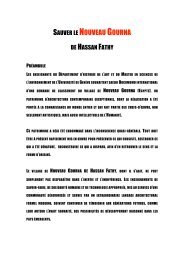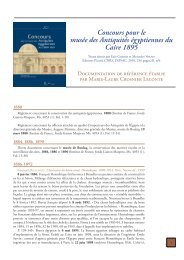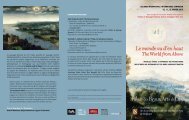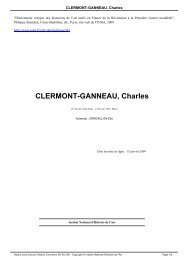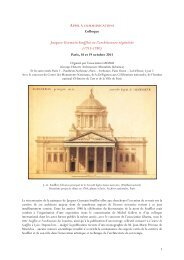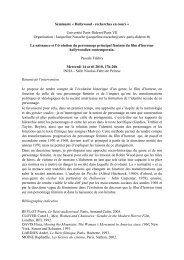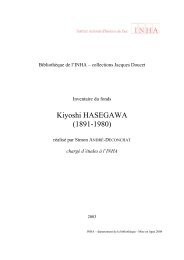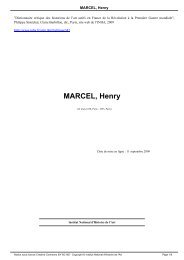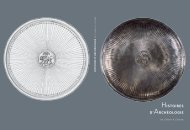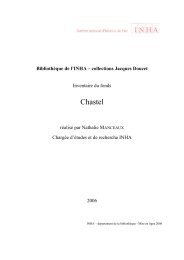Create successful ePaper yourself
Turn your PDF publications into a flip-book with our unique Google optimized e-Paper software.
Save Hassan Fathy’s<br />
<strong>New</strong> <strong>Gourna</strong><br />
Preamble<br />
The professors of the Department of Art History and of the Master in Environmental Sciences<br />
of the University of Geneva wish to make an emergency appeal to DOCOMOMO<br />
INTERNATIONAL for the registration of the village of <strong>New</strong> <strong>Gourna</strong> (Egypt). This exceptional<br />
masterpiece of contemporary architecture is famous worldwide and belongs to the artistic as well<br />
as to the intellectual heritage of Humanity.<br />
This heritage has already been severely damaged to somewhat general indifference. Every<br />
measure should now be rapidly carried out to preserve what is left, restore what has been altered<br />
and reconstruct what has disappeared to bring it back to its original form and signification.<br />
Hassan Fathy’s <strong>New</strong> <strong>Gourna</strong> village can not simply disappear through inertia and unconcern.<br />
The lessons of know-how/savoir-faire, human solidarity and appropriate technology put in the<br />
hands of a poor community are served by an extraordinary formal modern architectural<br />
language. They should continue to testify to future generations, as the architect himself would<br />
have wished, of the possibilities of reasoned development in emergent countries.<br />
Importance of Hassan Fathy<br />
Hassan Fathy (1900-1989) is among the most important architects of Africa and the Middle<br />
East. As an intellectual, writer, humanist, architect and scientist, he deeply influenced generations<br />
of architects and engineers throughout the world by his constructions as well as by his thought.<br />
Hassan Fathy was born in Alexandria and worked mainly in Egypt except for the five years he<br />
spent in Greece where he worked in the very cosmopolite Doxiades Agency in Athens (1957-<br />
1962). He became internationally famous after the success of the publication of <strong>Gourna</strong>, a Tale<br />
of two Villages in 1969, published again in 1973 under the name of Architecture for the Poor:<br />
An Experiment in Rural Egypt. The tremendous impact of the book shook the whole world and<br />
had significant repercussions in western academic circles.<br />
The richness of Hassan Fathy’s anthropological thought, his authentic social concern and the<br />
wisdom of his reasoning underlying architectural experience, have had an international blow<br />
1
which as yet to be assimilated in the era of sustainable development we are presently entering.<br />
The notion of “appropriate technology” formulated by Hassan Fathy at the twilight of his life<br />
has not been sufficiently acknowledged, in particular, in emergent countries.<br />
Hassan Fathy had a prolific mind and was passionate about numerous subjects. He designed<br />
and constructed projects of various nature; from modern constructions in armed concrete in the<br />
1930’s and private residences built with stone to projects for an “Ideal City” in Baghdad and<br />
Karachi during his Greek period. He addressed all types of programmes such as villas, farms,<br />
mosques, social health centres, schools, theatres, peasant villages and tourist villages. As a true<br />
researcher in the field of architecture and construction, he endeavoured to develop construction<br />
technologies by inventing solutions that would fit the climatic circumstances of hot arid<br />
countries. Although the project of NEW GOURNA is one of his important works, his career<br />
cannot be limited to this one and only realization.<br />
Hassan Fathy was motivated by a very strong social involvement combined with nationalist<br />
feelings and wished to develop adequate low-cost formulas drawn from the ancestral genius of<br />
the place, in priority for Egypt and then for the other Arab and African counties by which he was<br />
commissioned. The notion of “situated architecture” finds in him one of his champions. His<br />
constant concern was the integration of the building in its environment, finding inspiration in any<br />
possible heritage and answering the conditions imposed by the site.<br />
Hassan Fathy was a defender of traditional know-how and native crafts which were threatened<br />
of disappearing in favour of industrialized products imported from the West. Ideologically close<br />
to the artists of his time, like the group of the “Friends of Art and Life” founded in the 1930’s<br />
around the personality of Hamed Saïd, he preferred techniques which required the hand of man,<br />
believing they could bring happiness and dignity.<br />
Conscious of the importance of educating his compatriots and contemporaries, Hassan Fathy<br />
left numerous works and reports and gave a multitude of conferences. The memos, drafts,<br />
booklets scribbled with thoughts, notebooks and sketches are innumerable and constitute the<br />
most considerable part of the archives’ collection currently conserved at the American University<br />
of Cairo’s Rare Books Library and Special Collections (RBLSC). The classification of this<br />
material which is ongoing widens the knowledge of the vast and prolific production of this man.<br />
In his lifetime, he never received the recognition and grandstand he deserved even though in his<br />
late years, strangers from all over the world, desirous to benefit from his precepts, visited his<br />
house in Darb el Labana every day.<br />
Although Hassan Fathy was marginalized in his country, he was related to the international<br />
intelligentsias and he dedicated part of his career to expertise in the fields of development,<br />
2
African architecture and heritage. The thousands of photographs conserved at the RBSCL prove<br />
that he travelled in numerous countries all over the world, in Africa, Asia, the Middle East,<br />
Europe and the United-States. As a consultant for international organizations and UN agencies<br />
he elaborated development projects for countries such as Egypt, Iraq, Palestine and Pakistan.<br />
During his travels, he would always closely study the local architecture, whether modern or<br />
vernacular, as well as native crafts. These experiences were part of his training as an architect and<br />
theorist. Therefore he often illustrated his conferences and articles with examples of architecture<br />
or town-planning he discovered abroad.<br />
The bad fortune seems to be fiercely attached to Hassan Fathy’s production as several<br />
significant buildings have already disappeared: the Bosphore Casino (1932) commissioned by<br />
the Koudsy brothers on Train Station Square (Bab el-Hadid) in Cairo has fallen, several Deco<br />
villas from the 1930’s have been pulled down, the villa he built for his wife, Aziza Hassanein,<br />
was destroyed during the creation of the Maadi cornice and the legendary house of the artist and<br />
potter Hamed Saïd in el-Marg is now surrounded by a hostile environment. At present, the villa<br />
Toussoun Abu Gabal is threatened by the land-bank in progress (?) in the surroundings of the<br />
new Four Seasons Hotel. Recently, two houses built in the village of <strong>New</strong> Bariz (Kharga) have<br />
suffered renovations which have totally altered them.<br />
Hassan Fathy along with contemporary figures such as Nagib Mahfouz, Um Kalthoum or<br />
Yussef Shahin, incarnates the Egyptian genius. Nowadays, who would even think of letting the<br />
Trilogy of Mahfouz, Um Kalthoum’s songs or the cinematographic heritage of Yussef Shahin<br />
disappear? Meanwhile, because of quasi-general inactivity and fatalism, the outstanding<br />
realizations of a prominent architect are falling one after the other and NEW GOURNA is<br />
gradually vanishing.<br />
<strong>New</strong> <strong>Gourna</strong>: An Outstanding Conception<br />
Hassan Fathy’s owes his international recognition to the publication of <strong>Gourna</strong>, a Tale of two<br />
Villages which tells the adventure of the construction of the village of NEW GOURNA. The<br />
project and execution of this model-village for a poor traditional rural community, at the dawn of<br />
the 1950’s, happens to be an experience without precedent in Egypt. If the book narrating this<br />
experience still has an international echo today, the village which testifies of this unique and<br />
original attempt is in an advanced state of deterioration.<br />
In 1945, The Department of Antiquities and the Director of Excavations committed the building<br />
of a new village to Hassan Fathy, upstream of the old village of <strong>Gourna</strong>, behind the Memnon<br />
Colossuses. This pilot-village should have relocated the inhabitants of Old <strong>Gourna</strong> far away<br />
3
from the pharaonic sites. The Gournis opposed a strong resistance to this displacement.<br />
Recently, more than half a century later, they have been constrained by force to leave their<br />
houses in Old <strong>Gourna</strong> destroyed by bulldozers.<br />
This project meant for the modest Egyptian peasantry should be put in parallel with the research<br />
of the modern European architects of the inter-war period: whether in the domain of social<br />
housing for the working-class (Britz or Siemensstadt in Berlin by H. Sharoun, W. Gropius, B.<br />
Taut or the Kiefhook housing project in Rotterdam by J.J.P. Oud) or in the field of modelvillages<br />
of the Reconstruction which are starting to be seriously studied (Bousquel in France by<br />
Bossu and projects by Thomas Sharp in Great-Britain).<br />
Before planning anything, Hassan Fathy analyzes the existing situation. Indeed, he tries to<br />
improve the sanitary facilities and enhance the living conditions of the Gournis fellahs while<br />
preserving their cultural traditions. In order to build a new village that can answer the needs and<br />
customs of the inhabitants, he carries out a meticulous ethnographic approach by observing the<br />
functioning of Old <strong>Gourna</strong>. He studies the family (badana) and social structure of the clans or<br />
tribes and the way of life of the Gournis. These observations will dictate the principles<br />
underlying village-planning.<br />
Hassan Fathy also analyses the lucrative activities of the Gournis: in addition to land cultivation<br />
which provides them with insufficient resources are the licit income from native crafts and the<br />
illicit one from the fraudulent commerce of antiquities. This will favour his idea towards<br />
promoting a large variety of native crafts in the new village by perpetrating existing local<br />
traditions and reintroducing ancestral know-how.<br />
In his search for low-cost building solutions, Hassan Fathy uses the technology of raw earth<br />
which he has already experimented successfully in many circumstances. The material is costless<br />
and requires a technique that the Nubians still master. He wishes to hand this knowledge over to<br />
the Gournis to enable them to build their own houses themselves without the need of an<br />
architect. This self-help system would guarantee the durability of the village because it could<br />
develop in a sustainable way without an architect or professional mason, which the Gournis<br />
cannot afford. This pilot-project was to serve as a model for the construction of other low-cost<br />
villages in the poor rural areas of Egypt.<br />
<strong>New</strong> <strong>Gourna</strong>: An Exceptional Realization<br />
The site of <strong>Gourna</strong> is located on the western bank of the Nile at the level of Luxor with which it<br />
makes up Ancient Thebes. The western bank shelters the pharaoh’s necropolises (the Valley of<br />
the Kings, the Valley of the Queens and the Tombs of the Nobles), which number among the<br />
4
most visited sites in Egypt. As from the eighteenth century, dwellings have been built close by<br />
the tombs. This is what we call the Old <strong>Gourna</strong> that has just been evacuated and has been<br />
undergoing demolition since December 2006 in spite of international protests.<br />
Hassan Fathy was to design the project on a flat parcel in a 50 arpent hosha of farmable land,<br />
bought from Boulos Hanna Pasha, protected by dykes and situated close to the main road and<br />
the railway. It is on that piece of land that he freely designed the project of a pilot-village to<br />
relocate 7000 Gournis. Between 1946 and 1949 he will accomplish only part of the designed<br />
plan. The works will be suspended for lack of political support.<br />
This village neither resembles traditional villages nor the attempts to design modern Egyptian<br />
villages. It can be qualified as an ideal village just like the Saline de Chaux by Claude-Nicolas<br />
Ledoux was an industrial ideal town at the end of the Enlightenment. Hassan Fathy built <strong>Gourna</strong><br />
in keeping with his (high) idea of what an Egyptian village should be like in the middle of the<br />
twentieth century. The richness of the profoundly humanist programme of <strong>New</strong> <strong>Gourna</strong><br />
constitutes a unicum in the history of village-planning. It resulted in a very ambitious project,<br />
maybe too ambitious for its time and place.<br />
The fellah was to be housed with his family and animals in a dwelling designed according to his<br />
own needs. He was to breed his stock, cultivate the land in the surroundings of the village and<br />
also produce native crafts (weaving, pottery etc.) at the crafts’ school and the khan. He would<br />
then sell the harvest of his farming in a nice shaded market and his native crafts’ products in a<br />
hall built to this purpose. He would practise his faith either in a Mosque with pure lines or in a<br />
Copt church (which was not constructed). He would dispose of a meeting place for celebrations<br />
and feasts. His children would be sent to two distinct schools, one for the girls and the other for<br />
the boys. He would participate in the popular folkloric entertainment taking place at the theatre<br />
or on the esplanade situated just behind it. Part of the equipments (mosque, theatre, khan, market<br />
etc.) still exists today and does not appear as over- dimensioned considering the fact that Fathy<br />
was planning a possible population growth of 20.000 inhabitants.<br />
<strong>New</strong> <strong>Gourna</strong> was planned around a vast, irregular central public square encircled by the principal<br />
public buildings: mosque, mayor’s house, theatre, native crafts’ exhibition hall and khan. At the<br />
entrance of the village, nearby the railway, is the open-air market bordered by a range of halls to<br />
receive the visitors. The boys’ school (which has been demolished) was situated in the North-<br />
West sector of the village.<br />
The design of the village, deliberately irregular, between grid and radio-centric systems, was to<br />
develop the imaginary and encourage a rich and varied architecture. The village is divided into<br />
four main parts, separated by streets at least 10 meters wide, corresponding to the four Gourni<br />
5
tribes. A system of secondary streets, not exceeding a width of 6 m., protects the intimacy of the<br />
badanas and dissuades strangers from going any further. The inner court houses are assembled<br />
in more or less complex sectors open at the angles. This design deliberately avoids any<br />
systematic or symmetrical character and repetitions which lead, as Fathy says, “to boring rows<br />
of identical housing that are considered to be what the poor deserve” and are harmful to the<br />
human well-being of mankind.<br />
To solve the economic question of the rural village programme, Hassan Fathy uses raw brick.<br />
This choice is determined by his knowledge of the architecture and monuments of upper-Egypt.<br />
Indeed, in regions which are poor in wood, one has to imagine other roofing systems. The vaults<br />
and cupolas in raw brick like the Ramasseum, Bagawat and the Fatimid mausoleums, will serve<br />
him as models to roof his first experimental farms and the houses in <strong>New</strong> <strong>Gourna</strong>. In every<br />
epoch, the elementary technology of mud brick has been a traditional material in Egypt,<br />
particularly in rural areas. The material itself, immediately at hand, and the fabrication of the raw<br />
bricks, dried in the sun, is simple and low-cost. By applying the system of catenary vaults which<br />
he improves, Hassan Fathy can build a house entirely in earth. The building of such a house<br />
requires only two persons.<br />
The thermal inertia of raw brick walls has been studied and we know that it is superior to a wall<br />
in baked brick, in stone or in concrete. In consequence, the choice of this material for <strong>New</strong><br />
<strong>Gourna</strong>, located in an extreme desert climate region, is totally appropriate. The connotation of<br />
raw earth as being an archaic and poor material was one of the causes of the bad reception of<br />
<strong>New</strong> <strong>Gourna</strong> by the population for whom it was meant. The paradox of poor populations in<br />
emerging countries is that they aspire to industrialized technologies as a sign of wealth even if a<br />
material like concrete is totally inappropriate to the climatic and economic situation.<br />
Hassan Fathy created a particular formal language from earth technology; houses bearing thick<br />
walls with small openings roofed by domes and vaults. In drawing his inspiration from an<br />
ancestral technical tradition, he manages to invent a typology of habitations which is totally<br />
original though it also refers to the distribution of space in Islamic dwellings. The volumetric<br />
and special qualities of the ensemble have nothing to envy to modern western architecture and<br />
magnificently illustrate the famous phrase of le Corbusier: “l’architecture est le jeu correct,<br />
savant et magnifique des volumes sous la lumière”. The simple and refined geometry which<br />
governs the architectural conception imposes itself through its harmony. The aesthetics of the<br />
village just after it was completed, shown by the photographs of Dimitri Papadimou, call forth<br />
the geometric formalism of German and Dutch architects.<br />
This innovative formal language of Hassan Fathy at the time of its creation will have a long<br />
posterity in Egypt and around the Mediterranean. Today, in Egypt, one commonly uses the term<br />
6
of “Hassan Fathy style” even if it does not design raw earth constructions but any architecture<br />
using vaults and domes. Numerous tourist settlements and holiday houses reveal this general<br />
gusto.<br />
Exceptional character and uniqueness of <strong>New</strong> <strong>Gourna</strong><br />
In the aftermath of the Second World War, the idea and the execution of the village of <strong>New</strong><br />
<strong>Gourna</strong> constitute an experience without precedent. It is both unique in its time and premonitory<br />
of the preoccupations that were to come. The idea of a self-help system among the peasants<br />
intended towards the building of their own houses adapted to the climate with a simple and lowcost<br />
technology is an exception. Hassan Fathy was sensitive to the question of social housing as<br />
an architect and as a man and sincerely wished to enhance the living conditions of the peasants.<br />
He invented a model-housing based upon constructive and typological models from the<br />
historical range of Egyptian constructions. This concern for re-linking with the lost traditional<br />
know-how anticipates the theories underlying the question of sustainable development.<br />
Because of the extreme abundance of heritage from all epochs, Egypt is essentially preoccupied<br />
by antiquities, Islamic and Coptic arts and does not yet recognise the more recent heritage; this is<br />
why the concern for the village of <strong>New</strong> <strong>Gourna</strong> has not been considered as a priority.<br />
Nevertheless, it constitutes an exceptional cultural conception and heritage.<br />
<strong>New</strong> <strong>Gourna</strong>, Hassan Fathy’s pilot-project which has been partially constructed is at present<br />
abandoned and in peril. Even though the theatre and the mosque have been restored and are in a<br />
good state of conservation, some of the buildings suffer from lack of maintenance and savage<br />
transformations. Other buildings, like the boys’ school and the native crafts’ hall of the village<br />
have been purely and simply destroyed.<br />
In consequence, the professors of the Department of Art History and of the Master in<br />
Environmental Sciences of Geneva University in Geneva, are taking the initiative of a demand<br />
for international registration of <strong>New</strong> <strong>Gourna</strong> as a Docomomo listed heritage.<br />
7


